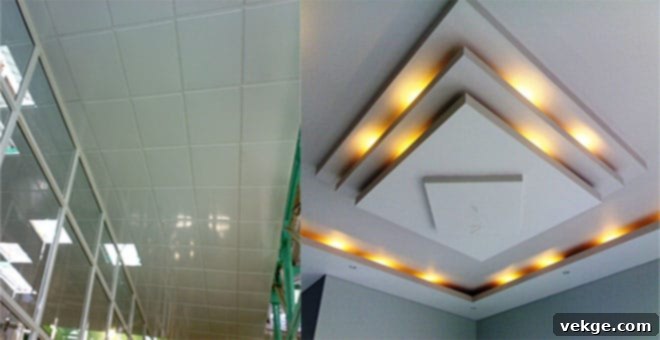Elevate Your Interiors: Exploring Diverse Ceiling Types for Modern Homes & Offices
When embarking on an interior design project, whether it’s a full renovation or a simple refresh, our focus often gravitates towards walls, flooring, and furniture. However, one crucial element that significantly impacts the overall aesthetic, ambiance, and functionality of a space often gets overlooked: the ceiling. Far from being merely a structural top cover, the ceiling is a fifth wall, a canvas that can transform a room from ordinary to extraordinary. It influences lighting, acoustics, and even the perceived size of a room.
Choosing the right ceiling material and design can be a pivotal decision in defining your interior spaces. It’s a conversation best had with an interior architect or designer who can guide you through the myriad of options available. From the warmth of wood to the sleekness of metal, the transparency of glass, the practicality of PVC, or the softness of fabric, each material offers unique advantages and disadvantages that cater to different design visions, functional requirements, and budgetary constraints.
This comprehensive guide will delve into various popular types of ceilings, exploring their characteristics, typical applications, and the essential pros and cons associated with each. By understanding these aspects, you’ll be equipped with well-informed insights to select the most ideally suited ceiling finish for your home decor or office spaces, ensuring your interior design reaches its full potential.
1. Wooden Ceilings
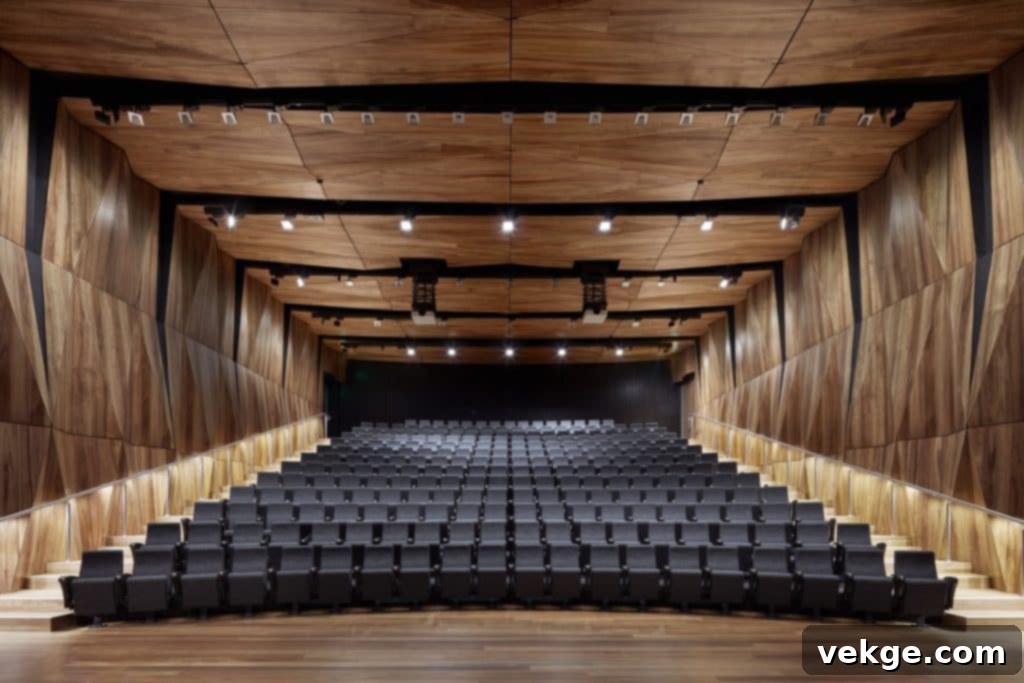
For those seeking to infuse their spaces with a touch of rustic charm, timeless elegance, or a warm, natural appeal, wooden ceilings are an unparalleled choice. Whether it’s a cozy living room, a sophisticated home office, or a chic restaurant, a wooden ceiling instantly lends a classy and inviting atmosphere. They can range from traditional exposed beams to sleek, modern paneling, offering immense versatility in design. Materials like plywood, MDF, or solid wood planks can be fashioned into various shapes, sizes, and intricate designs, making customization a breeze.
Pros of Wooden Ceilings:
- Aesthetic Versatility: Wooden ceilings come in a vast array of finishes, stains, and grain patterns. You can opt for a light, airy look with bleached wood or a rich, opulent feel with dark mahogany. They can be installed as false ceilings, panels, or decorative beams, adapting to any interior style from traditional to contemporary.
- Durability and Sturdiness: Wood, when properly treated and maintained, is an incredibly durable and long-lasting material. It can withstand the test of time, offering a robust ceiling solution.
- Natural Sound Absorption: Wood naturally absorbs sound, contributing to better acoustics within a room. This makes wooden ceilings an excellent choice for living areas, offices, or commercial spaces where noise reduction is desired.
- Thermal Insulation: Wood offers natural insulation properties, helping to regulate indoor temperatures. This can lead to energy savings by keeping spaces warmer in winter and cooler in summer.
- Variety of Options: From simple planks to intricate coffered designs, or even modern slatted styles, wooden ceilings can be tailored to specific design requirements, offering endless creative possibilities.
Cons of Wooden Ceilings:
- High Maintenance: Wooden ceilings require more attentive maintenance. They are susceptible to damage from water leakage, which can lead to warping, staining, or mold growth. Termite infestations are also a concern, necessitating regular inspections and treatments.
- Fire Hazard: Unlike some other materials, wood is not inherently fire-resistant. While treatments can improve its resistance, it remains a combustible material, which can be a safety consideration depending on building codes and personal preferences.
- Cost: High-quality wood and intricate designs can make wooden ceilings a more expensive option compared to some alternatives, both in terms of material and installation.
- Weight: Solid wood ceilings can be heavy, requiring robust structural support, which might add to installation complexity and cost.
2. Glass Ceilings
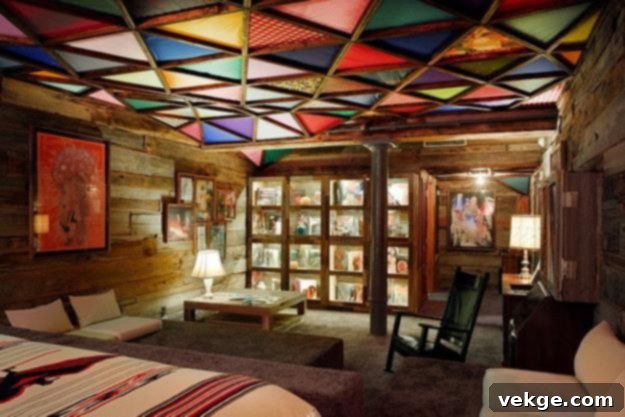
Glass ceilings are synonymous with modernity, sophistication, and an abundance of natural light. They are a design statement, often found in contemporary libraries, high-end restaurants, expansive corporate offices, and even residential conservatories or sunrooms. Glass ceilings create an illusion of boundless space and seamless connection with the outdoors, making rooms feel larger, brighter, and more open. They can be utilized as full ceiling panels or as decorative accents within a traditional ceiling structure, offering incredible aesthetic appeal.
Pros of Glass Ceilings:
- Majestic Appearance and Light Maximization: Glass ceilings are visually stunning. They allow natural light to flood into spaces, reducing the need for artificial lighting during the day and creating a vibrant, airy atmosphere. This not only enhances the aesthetic but can also contribute to energy savings.
- Illusion of Space: By reflecting light and offering transparency, glass makes rooms appear significantly larger and more expansive, ideal for smaller areas or those aiming for an open-plan feel.
- Design Versatility: Glass can be customized in various forms – clear, frosted, tinted, stained, or etched – offering diverse aesthetic possibilities. Pre-fabricated glass ceiling panels are available in numerous designs, shapes, and colors, facilitating integration into existing setups or new constructions.
- Modern and Chic Appeal: Glass perfectly complements minimalist and contemporary design themes, adding a touch of elegance and cutting-edge style.
Cons of Glass Ceilings:
- High Cost: Glass ceilings are generally among the most expensive ceiling options. The cost includes not only the specialized glass itself but also the sophisticated installation techniques and structural reinforcement often required.
- Tedious Maintenance: Glass surfaces are prone to collecting dust, smudges, and water spots, requiring frequent and careful cleaning to maintain their pristine appearance. This can be particularly challenging for overhead installations.
- Fragility: Despite advancements in safety glass (tempered or laminated), glass ceilings remain inherently more fragile than other materials and can break under impact, posing a safety risk.
- Heat Gain/Loss: Unless specifically treated (e.g., low-E coatings), glass can lead to significant heat gain in summer and heat loss in winter, impacting indoor climate control and energy efficiency.
- Privacy Concerns: Transparency can be a disadvantage in some settings, raising privacy issues, especially in multi-story buildings or urban environments.
3. PVC Ceilings
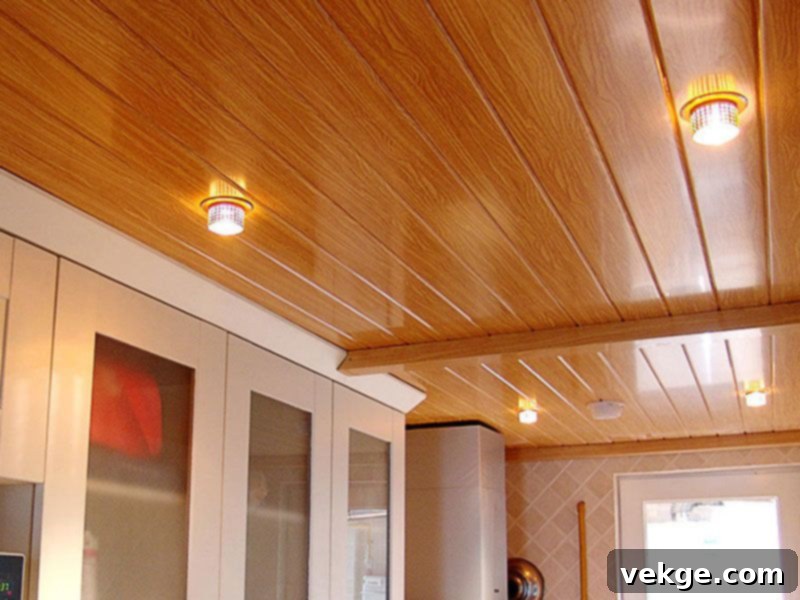
PVC, or Polyvinyl Chloride, is a highly popular and practical material for ceiling applications, especially in areas where moisture resistance and ease of maintenance are paramount. Commonly seen in basement ceilings, bathrooms, kitchens, and other utility areas, PVC panels offer a clean, seamless finish that is both functional and aesthetically pleasing. They are lightweight, durable, and come in a wide array of designs, making them a cost-effective alternative to more traditional materials.
Pros of PVC Ceilings:
- Cost-Effectiveness: PVC ceilings are significantly more affordable than options like wood or glass, making them an excellent choice for budget-conscious projects.
- Waterproof and Moisture Resistant: This is a key advantage of PVC. It is completely impervious to water, making it ideal for high-humidity environments like bathrooms, kitchens, and basements where other materials would quickly deteriorate.
- Easy Installation: PVC panels are lightweight and designed for straightforward interlocking installation, which can often be a DIY project, saving on labor costs.
- Durability and Low Maintenance: PVC is a robust material that resists warping, rusting, and pest infestations. It requires minimal maintenance; a simple wipe-down with a damp cloth is usually sufficient to keep it clean.
- Variety of Designs: Modern PVC ceilings are available in an astounding range of hues, shades, patterns, and designs. They can mimic the look of wood, metal, or even decorative plaster with impressive realism, offering great flexibility in achieving desired aesthetics.
- Hygienic: Their smooth, non-porous surface prevents the growth of mold and mildew, contributing to a healthier indoor environment.
Cons of PVC Ceilings:
- Heat Resistance Issues: PVC ceilings are not highly heat resistant. Prolonged exposure to high temperatures can cause them to warp or discolor. They are generally not recommended for areas near intense heat sources without proper insulation or spacing.
- Aesthetic Perception: While PVC has made great strides in design, some may still perceive it as a less luxurious or “natural” material compared to wood or glass, lacking the inherent charisma of natural elements.
- Chemical Composition: As a chemically bonded material, PVC may release volatile organic compounds (VOCs) during installation or when exposed to high temperatures, though modern formulations often reduce this concern.
- Environmental Impact: PVC production and disposal can raise environmental concerns, though recycling efforts are improving.
4. Fabric Ceilings
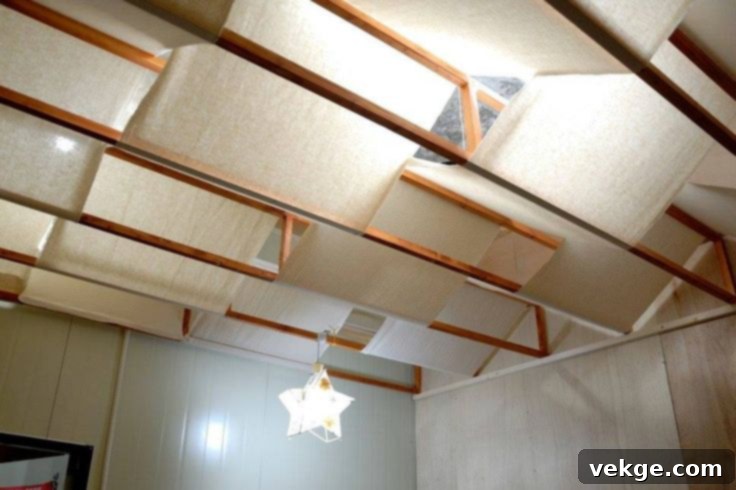
Fabric ceilings are a distinct and often temporary design solution, typically employed to create specific ambiances for events, exhibitions, or in spaces where a soft, dramatic, or unique aesthetic is desired. Think of the elegant drapes in wedding halls, the creative installations at exhibition stands, or even stretch fabric systems in high-end retail spaces. These false ceilings, made from various textile materials, are primarily ornamental, focusing on visual impact and often acoustic enhancement rather than structural permanence.
Pros of Fabric Ceilings:
- Relatively Cheaper and Easy to Install: For temporary applications, fabric ceilings can be very cost-effective and are generally quick and easy to install, often requiring less specialized labor.
- Aesthetic Flexibility: Fabric offers an incredible range of colors, textures, patterns, and draping styles. It can create soft, flowing forms, geometric patterns, or even intricate designs, perfectly suiting specific events, themes, or interior design concepts.
- Acoustic Benefits: Many fabrics possess excellent sound-absorbing qualities, which can significantly improve the acoustics of a room by reducing echo and reverberation. This is particularly beneficial in large halls, auditoriums, or bustling commercial spaces.
- Light Diffusion: Certain fabrics can diffuse overhead lighting, creating a softer, more ambient glow rather than harsh direct light, enhancing mood and comfort.
- Temporary and Versatile: Fabric ceilings are ideal for make-shift installations, events, or when a quick, impactful change in decor is needed without permanent alteration to the structure.
Cons of Fabric Ceilings:
- Limited Light Penetration: Most fabric ceilings inherently block or significantly reduce the passage of natural light, which can make a room feel darker unless augmented with extensive artificial lighting.
- Susceptibility to Stains and Dust: Fabric surfaces easily collect dust, grime, and can stain, requiring regular cleaning or replacement, especially in high-traffic areas or environments prone to dirt.
- Durability Concerns: Fabric is less durable than rigid ceiling materials and is susceptible to tearing, fraying, or sagging over time, particularly with prolonged use or improper handling.
- Fire Safety: Unless specifically treated with fire-retardant chemicals, many fabrics can be a fire hazard, necessitating careful selection and adherence to safety regulations.
- Not a Permanent Solution: Fabric ceilings are generally not considered a long-term, structural ceiling solution due to their material properties and maintenance requirements.
5. Metallic Ceilings

Metallic ceilings embody strength, modernism, and a distinct industrial-chic aesthetic. They are a popular choice for commercial spaces, industries, contemporary offices, and even residential interiors aiming for a bold, urban look. Metals like aluminum, steel, tin, or copper can be fabricated into panels, tiles, or intricate grilles, offering a sleek, durable, and sophisticated finish. Their reflective properties can also contribute to brighter spaces, while their inherent robustness ensures longevity.
Pros of Metallic Ceilings:
- Durability and Longevity: Metal is exceptionally robust and long-lasting. It resists wear and tear, making metallic ceilings a highly durable investment that can withstand the rigors of commercial or industrial environments.
- Easy to Install and Maintain: Many metallic ceiling systems, such as grid-based false ceilings, are designed for straightforward installation. They are also relatively easy to clean and maintain, usually requiring just a wipe-down.
- Lightweight with Great Texture: Despite their perceived strength, many metallic ceiling panels are lightweight, reducing the load on structural elements. They also offer a vast array of textures, perforations, and finishes, from brushed to mirrored, allowing for unique design expressions.
- Fire-Resistant: Metal is non-combustible, making metallic ceilings highly fire-resistant, which is a significant safety advantage, especially in commercial and public buildings.
- Versatility and Detachability: Metallic false ceilings are often designed for easy detachment and re-attachment, allowing convenient access to overhead utilities like wiring, plumbing, and HVAC systems. They are available in various shapes, sizes, colors, and designs, including embossed patterns.
- Modern and Industrial Aesthetic: Metallic ceilings perfectly suit modern, minimalist, and industrial design themes, adding a sophisticated and edgy touch to any space.
Cons of Metallic Ceilings:
- Higher Cost: Metallic ceilings, particularly those made from higher-grade metals or with intricate designs, can be more expensive than PVC or even some wooden options.
- Corrosion and Rust: While durable, some metals, especially in humid environments, may require protective coatings or specific alloys to guard against rust or corrosion over time, which can add to maintenance.
- Noise Reflection: Metal surfaces can be highly reflective of sound, potentially leading to increased noise and echo in a room if not combined with acoustic treatments.
- Installation Skill: While installation can be straightforward for basic systems, achieving a flawless, high-end metallic ceiling often requires skilled installers to ensure precision and prevent blemishes.
Choosing Your Perfect Ceiling: Factors to Consider
Selecting the ideal ceiling material is a decision that extends beyond mere aesthetics. To ensure your choice perfectly aligns with your needs, consider the following key factors:
- Room Function: A bathroom will require a moisture-resistant ceiling (like PVC), while a living room might prioritize aesthetics and acoustics (wood, fabric). An office may benefit from the durability and maintenance ease of metal or PVC.
- Desired Aesthetic: Are you aiming for rustic charm, modern sleekness, temporary elegance, or industrial chic? Each material lends itself to a specific visual style.
- Budget: Ceiling costs vary significantly. PVC offers an affordable solution, while glass and high-end wood or metal can be substantial investments.
- Maintenance Requirements: Consider how much time and effort you’re willing to dedicate to cleaning and upkeep. Some materials are virtually maintenance-free, while others demand regular attention.
- Durability and Longevity: For long-term solutions, robust materials like metal or well-maintained wood are excellent. For temporary changes, fabric is more suitable.
- Acoustics: If sound absorption is critical (e.g., in a home theater or busy office), wood or fabric can be beneficial. Metal and glass might require additional acoustic treatments.
- Lighting and Natural Light: If maximizing natural light is a priority, glass is superior. Materials that diffuse light (some fabrics, certain PVC designs) can create a softer ambiance.
- Climate and Environment: In humid climates, moisture-resistant materials are essential. Fire resistance might be a concern depending on local regulations and personal safety priorities.
- Structural Considerations: Heavier materials like solid wood might require additional structural support, which should be assessed by a professional.
Conclusion
The ceiling, often an unsung hero of interior design, plays a pivotal role in shaping the character, comfort, and functionality of any space. From the grounding warmth of wooden ceilings and the expansive clarity of glass, to the practical resilience of PVC, the soft artistry of fabric, and the contemporary strength of metallic finishes, the options are diverse and exciting.
Before making your final decision, it is paramount to look beyond initial appearances and carefully consider each material’s durability, strength, and maintenance requirements. A beautiful wooden ceiling, for instance, offers unparalleled warmth but demands protection against water damage and termites. In contrast, PVC or metallic ceilings provide robust, low-maintenance solutions, especially in challenging environments.
Ultimately, the best ceiling for your home or office is one that perfectly balances your aesthetic desires with practical considerations like budget, room function, and long-term upkeep. By thoughtfully evaluating these important factors and perhaps consulting with design professionals, you can ensure your chosen ceiling not only elevates your space visually but also serves its purpose efficiently and beautifully for years to come.
